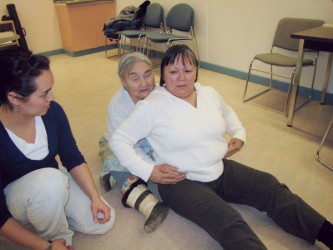Article Origin
Volume
Issue
Year
Long before the introduction of stirrups and forceps, generations of Inuit babies were being born in Canada’s far north. Birthing practices were passed down from mother to daughter, and the people continued to thrive in the harsh climate of their homeland. Many of their stories are preserved and shared in a new book by Beverly O’Brien, registered midwife and nursing professor at the University of Alberta.
Birth on the Land: Memories of Inuit Elders and Traditional Midwives was published late last year and was recently introduced in the Nunavut legislature. Available in both Inuktitut and English, the book will be given to students participating in the midwifery program through Nunavut Arctic College and Laurentian University.
Sharing these stories was a labour of love and respect by O’Brien, who started working at nursing stations in communities on Baffin Island about 30 years ago. When she set out to work as a nurse practitioner in Canada’s North, O’Brien quickly realized that her real learning had just begun. She was armed with all the training and expertise that her formal education could provide, but her northern patients would soon show her the depth of culture and tradition that had kept them alive and well for thousands of years.
Learning about Inuit ways was an awakening for her. “I would learn what a cultural tradition was, and I would find out how off-base I was,” she said. “Safe practice was not necessarily culturally safe.”
One example she recalled was the difference between birthing on the land or at the nursing station: “You had to give birth on your back, which was absurd to them. They squatted. When we came and insisted that they lie on their backs, we probably created complications that hadn’t existed before. Every birth is not necessarily a harrowing experience.”
For the young Inuit women who grew up listening to their mothers’ stories, these clinical environments were a conflict. “Do I listen to my mother or to these people from the south?” she says. “Everyone was well-intended but without knowing it, I think maybe we just weren’t respectful enough. I can’t speak for everyone, but I suspect we didn’t understand who they were or how competent they were.”
And so O’Brien considered her own future path. “Babies did get born whether or not these women went to a hospital in the south, and I knew I needed to know more about that. I decided that I really wanted to be a midwife.”
In 1987, she enrolled at Rush University in Chicago, a member of the U.S. College of Midwives. Three years later, doctorate in hand, she accepted a position as assistant professor at the University of Alberta. At that point, midwifery was still in the regulation phase, she says. “Not until 1997 were we able to be licensed.”
With roughly 70 per cent of expectant mothers in the north still travelling to Winnipeg to give birth, the shortage of qualified midwives and the revolving door of southern workers made it clear that a program dedicated to educating Inuit midwives was critical. O’Brien was invited to help coordinate a training program in partnership with Nunavut Arctic College in Iqaluit and Laurentian University in Sudbury, Ontario.
The program would meet Canadian maternity care standards as well as Inuit cultural standards, allowing students to reach four different levels that range from maternity care worker to midwifery degree. The course accepted its first students in 2005, and to date, 10 care workers have graduated, two midwives (both now working in Rankin Inlet, NWT) and two students are now working on their interdisciplinary orientation in Winnipeg. They will graduate next year.
Published by Nunavut Arctic College with funding from the territorial government, O’Brien’s book is now a valuable learning resource. A copy is given to all students who enter the midwifery education program. “One of the four things they told me when they hired me was to ensure that every course had traditional knowledge. The idea for the book got lots of support from the college and from the government of Nunavut.”
Over the course of many months, O’Brien and an Inuktitut translator met with the women who told of their own experiences or memories from their mothers or grandmothers. “I was always aware that people reading the book might not want medical terminology, so I tried to use the translated language of these women,” she said.
“When I talk about them, it’s a snapshot in time while I was with them and able to hear some of their stories,” said O’Brien. “It was an honour, and quite humbling.”
She points out that her work in course development and the production of her book were team projects and she shares credit for the accomplishments with her colleagues at Nunavut Arctic College, Laurentian University and the University of Alberta.
- 3621 views

